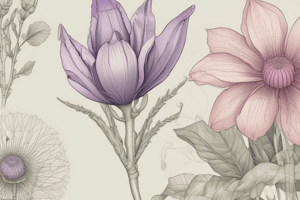Podcast
Questions and Answers
What is the main function of the ovary?
What is the main function of the ovary?
- Producing pollen grains
- Secreting nectar for pollination
- Developing into seeds after fertilization (correct)
- Providing support to the stem
What does placentation refer to?
What does placentation refer to?
- The process of seed formation
- The arrangement of ovules within the ovary (correct)
- The development of pollen grains
- The transfer of pollen from anther to stigma
In what type of placentation are ovules attached along a central column?
In what type of placentation are ovules attached along a central column?
- Marginal placentation
- Free central placentation
- Parietal placentation
- Axile placentation (correct)
What does the pericarp of a fruit refer to?
What does the pericarp of a fruit refer to?
What happens after fertilization in relation to the ovary?
What happens after fertilization in relation to the ovary?
Which type of placentation forms a ridge along the ventral suture of the ovary?
Which type of placentation forms a ridge along the ventral suture of the ovary?
What is the main role of placentation in a plant's reproductive system?
What is the main role of placentation in a plant's reproductive system?
What does the false septum in an ovary signify?
What does the false septum in an ovary signify?
Flashcards are hidden until you start studying
Study Notes
Placenta in Flowers
- Placenta is the region where ovules are attached to the ovary wall
- Ovary is the female reproductive organ in flowers, and it can be one-chambered or two-chambered
- In some flowers, the placenta is along the ventral suture of the ovary, and ovules are arranged in a row (marginal placentation)
- In other flowers, the placenta is axial and ovules are attached to a multicellular ovary (axial placentation)
Types of Placenta
- Marginal placentation: ovules are arranged in a row along the ventral suture of the ovary
- Axial placentation: ovules are attached to a multicellular ovary
- Free-central placentation: ovules are attached to a central column in the ovary
- Paracentral placentation: ovules are attached to the ovary wall, but not along the ventral suture
Fruit Development
- After fertilization, the ovary develops into a fruit
- The pericarpe (fruit wall) can be dry or fleshy
- Each ovule develops into a seed, and each seed has an embryo and a stored food supply
- The fruit can have different types of placentation, depending on the type of ovary and ovule arrangement
Ovary Structure
- The ovary can be one-chambered or two-chambered
- The ovary wall has a placenta where ovules are attached
- The ovary can have different types of placentation, depending on the arrangement of ovules
- The ovary develops from a floral meristem, which is a group of undifferentiated cells
Studying That Suits You
Use AI to generate personalized quizzes and flashcards to suit your learning preferences.





